Monitor and Trace
The Monitor and Trace tab displays the results of filtered SIP session data from the Oracle Enterprise Communications Broker in categorical lists. Each of the lists displays the results in a common log format for local viewing, which you can export as HTML and text files.
When you click the Monitor and Trace tab, the Web GUI displays links to the available lists in the navigation pane and defaults to Sessions. In the white space below the list, the GUI displays the total number of entries in the list and the numbers of the entries currently in view. The counter is dynamic and changes the enumeration as you scroll through the list. The following screen capture shows the Monitor and Trace default display.

Each summary provides sorting, searching, paging, and exporting functionality, as well as a ladder diagram view where you can see a session summary, session details, and QoS statistics. You can choose which columns that you want each summary list to display by right clicking any column header and selecting column names from the pop-up list. The available column names vary according to the list type.
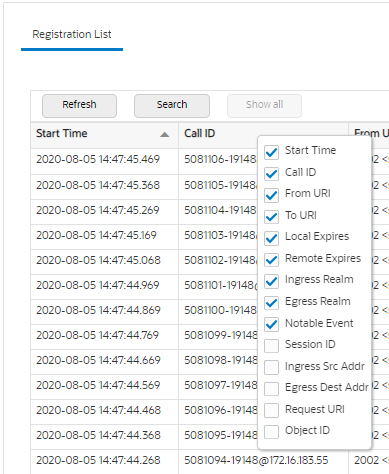
- On systems with less than 4GB of RAM,
the system can store:
- 50 messages
- 2,000 sessions
- On systems with more than 4GB of RAM,
the system can store:
- 50 messages
- 4,000 sessions
The system can perform live paging from Monitor and Trace tables.
Note:
Only one user at a time can view Monitor and Trace information. Monitor and Trace does not support multiple, simultaneous viewers.SIP Notable Events Summary
The SIP Notable Events Summary contains all logged sessions that have a notable event on the Oracle Enterprise Communications Broker (ECB) associated with the session. The columns that display on the Notable Events Summary page depend on the columns that you selected in the "Customizing the Page Display" procedure.
The following table describes the columns that Notable Events Summary page can display.
| Start Time | Timestamp of the first SIP message in the call session. |
| State | Status of the call or media event session. Valid
values:
INITIAL—Session for which an INVITE or SUBSCRIBE was forwarded. EARLY—Session received the first provisional response (1xx other than 100). ESTABLISHED—Session for which a success (2xx) response was received. TERMINATED—Session that has ended by receiving or sending a BYE for an “Established” session or forwarding an error response for an “Initial” or Early session. The session remains in the terminated state until all the resources for the session are freed up. FAILED Session that has failed due to a 4xx or 5xx error code. |
| Call ID | Identification of the call source. Includes the phone number and source IP address. |
| Request URI | Uniform Resource Identifier (URI) formatted string that identifies a resource through a protocol, name, location, and any other applicable characteristic, and is sent by the ECB in REQUEST headers. |
| From URI | URI formatted string that identifies the call source information. |
| To URI | URI formatted string that identifies the call destination information. |
| Ingress Realm | Name of the inbound realm. |
| Egress Realm | Name of the outbound realm. |
| Notable Event | Indicates if a notable event has occurred on the
call session. Valid values:
short session—Sessions that don’t meet a minimum configurable duration threshold; Session dialogue, captured media information and termination signalling; Any event flagged as a short session interesting event. local rejection—Sessions locally rejected at the ECB for any reason (for example, Session Agent (SA) unavailable, no route found, SIP signalling error, etc.); Session dialogue, capture media information and termination signaling; Any event flagged as a local rejection interesting event. |
| Session ID | Identification assigned to the call session. |
| Ingress Src Addr | Source IP address of the incoming call or media event. |
| Ingress Src Port | Source port of the incoming call or media event. |
| Egress Dest Addr | Destination IP address of the outgoing call or media event. |
| Object ID | ID number of the object in a row. Use to aid troubleshooting. |
SIP Registrations Summary
The SIP Registrations Summary displays a summary of all logged SIP registrations sessions on the Oracle Enterprise Communications Broker (ECB). The columns that display on the Registrations Summary page depend on the columns you selected in the "Customizing the Page Display" procedure.
The following table describes the columns available on the Registrations Summary page.
| Start Time | Timestamp of the first SIP message in the call session. |
| Call ID | Identification of the call source. Includes the phone number and source IP address. |
| From URI | URI formatted string that identifies the call source information. |
| To URI | URI formatted string that identifies the call destination information. |
| Local Expires | The current setting for the expiration of a registration request sent from the Integrated Media Gateway (IMG) to a Remote SIP User Agent. Default: 3600 seconds. |
| Remote Expires | The current setting for the expiration of a registration request sent from the Remote SIP User Agent to the Integrated Media Gateway (IMG). Default: 3600 seconds. |
| Ingress Realm | Incoming realm name. |
| Egress Realm | Outgoing realm name. |
| Notable Event | Indicates a notable event that occurred on the call
session. Valid value:
local rejection - Sessions locally rejected at the E-SBC for any reason (for example, Session Agent (SA) unavailable, no route found, SIP signalling error, etc.); Session dialogue, capture media information and termination signalling; Any event flagged as a local rejection interesting event |
| Session ID | Identification assigned to the call session. |
| Ingress Src Addr | Source IP address of the incoming call or media event. |
| Egress Dest Addr | Destination IP address of the outgoing call or media event. |
| Request URI | Uniform Resource Identifier (URI) formatted string that identifies a resource with the protocol, name, location, and any other applicable characteristic. The SBC only sends the URI in REQUEST headers. |
| Object ID | ID number of the object in a row. Use to aid troubleshooting. |
SIP Sessions Summary
The SIP Sessions Summary summarizes all logged call sessions on the Oracle Enterprise Communications Broker (ECB). When you enable Lightweight Directory Access Protocol (LDAP) on the Active Directory, LDAP session messages may also display. The columns that display on the Sessions Summary page depend on the columns that you specified in the "Customizing the Page Display" procedure.
The following table describes the columns on the SIP Session Summary page.
| Start Time | Timestamp of the first SIP message in the call session. |
| State | Status of the call or media session. Valid values
are:
INITIAL—Session for which an INVITE or SUBSCRIBE was forwarded. EARLY—Session that received the first provisional response (1xx other than 100). ESTABLISHED—Session for which a success (2xx) response was received. TERMINATED—Session that ended by receiving or sending a BYE for an “Established” session or forwarding an error response for an “Initial” or "Early" session. The session remains in the terminated state until all the resources for the session are freed up. FAILED—Session that failed due to a 4xx or 5xx error code. |
| Call ID | Identification of the call source. Includes the phone number and source IP address. |
| Request URI | Uniform Resource Identifier (URI) formatted string that identifies a resource by way of a protocol, name, location, and any other applicable characteristic that is sent by the ECB in REQUEST headers. |
| From URI | URI formatted string that identifies the call source information. |
| To URI | URI formatted string that identifies the call destination information. |
| Ingress Realm | Name of the inbound realm. |
| Egress Realm | Name of the outbound realm. |
| Duration | Amount of time, in seconds, that the call or media event was active. |
| Notable Event | Indicates if a notable event has occurred on the
call session. Valid values are:
Short Session—Sessions that do not meet a minimum configurable duration threshold. Session dialogue, captured media information, and termination signalling. Any event flagged as a short session interesting event. Local Rejection—Sessions locally rejected at the ECB for any reason, for example, Session Agent (SA) unavailable, no route found, SIP signaling error, and so on. Session dialogue, capture media information, and termination signaling. Any event flagged as a local rejection interesting event. |
| Session ID | Identification assigned to the call session. |
| Ingress Src Addr | Source IP address of the incoming call or media event. |
| Egress Dest Addr | Destination IP address of the outgoing call or media event. |
| Calling Pkts | Number of calling packets. |
| Called Pkts | Number of called packets. |
| Calling R | Calling packets R-Factor calculation. |
| Called R | Called packets R-Factor calculation. |
| Calling MOS | Calling packets Mean Opinion Score (MOS) calculation. |
| Called MOS | Called packets Mean Opinion Score (MOS) calculation. |
| Ingress Src Port | Source port of the incoming call or media event. |
| Object ID | ID number of the object in a row. Use to aid troubleshooting. |
Display a Sessions Report
SIP Message Details
The SIP Message Detail window displays detailed information and data flow (ingress and egress) about the call or media event.
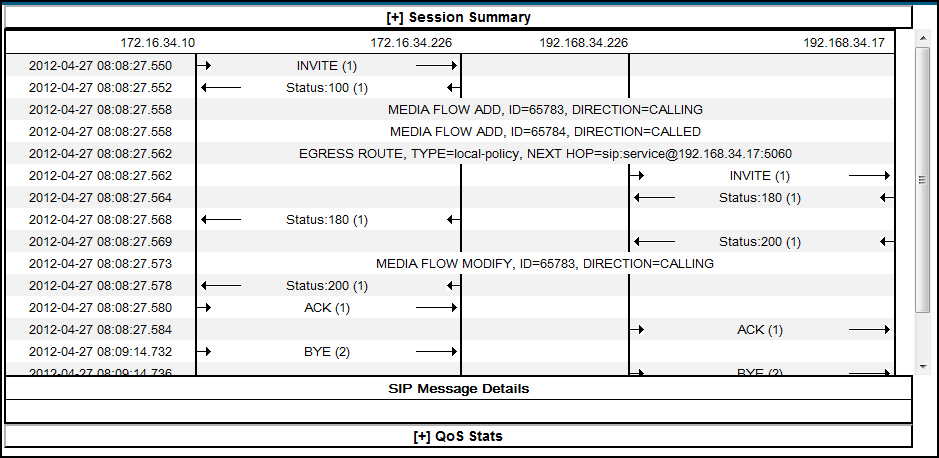
When a session is routed using the a Lightweight Directory Access Protocol (LDAP) configuration (Active Directory) for the local policy, the LDAP information displays in the Session Summary window. The next hop value containing "enum:…" or "dns:…" displays. Similarly, the next hop value "ldap:…" displays for LDAP queries.
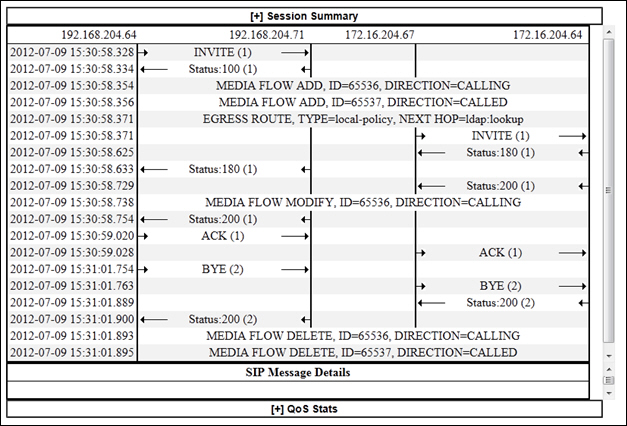
SIP Subscriptions Summary
The SIP Subscriptions Report displays a summary of all logged SIP subscription sessions on the Oracle Enterprise Communications Broker (ECB). The columns that display on the Subscription Report page depend on the columns you selected in the "Customizing the Page Display" procedure.
The following table describes the columns on the Subscriptions Report page.
| Start Time | Timestamps of the first SIP message in the call session. |
| Call ID | Identification of the call source. Includes the phone number and source IP address. |
| From URI | URI formatted string that identifies the call source information. |
| To URI | URI formatted string that identifies the call destination information. |
| Events | Specific subscribe event package that was sent from an endpoint to the
destination endpoint. Applicable event packages include the following:
Conference—Event package that allows users to subscribe to a conference Uniform Resource Identifier (URI). Consent—pending additions - Event package used by SIP relays to inform user agents about the consent-related status of the entries to be added to a resource list. Dialog—Event package that allows users to subscribe to another user, and receive notifications about the changes in the state of the INVITE-initiated dialogs in which the user is involved. Message—summary - Event package that carries message-waiting status and message summaries from a messaging system to an interested User Agent (UA). Presence—Event package that conveys the ability and willingness of a user to communicate across a set of devices. A presence protocol is a protocol for providing a presence service over the Internet or any IP network. Reg—Event package that provides a way to monitor the status of *all* the registrations for a particular Address of Record (AoR). Refer—Event package that provides a mechanism to allow the party sending the REFER to be notified of the outcome of a referenced request. Winfo—Event package for watcher information. It tracks the state of subscriptions to a resource in another package. Vvq-rtcpx—Event package that collects and reports the metrics that measure quality for RTP sessions. |
| Expires | The current setting for the expiration of a registration request. Default: 3600 sec. |
| Ingress Realm | Incoming realm name. |
| Egress Realm | Outgoing realm name. |
| Notable Event | Indicates that a notable event occurred on the call session. Valid value is:
local rejection - Sessions locally rejected at the ECB for any reason (for example, Session Agent (SA) unavailable, no route found, SIP signaling error); Session dialogue, capture media information and termination signaling; Any event flagged as a local rejection interesting event |
| Session ID | Identification assigned to the call session. |
| State | Status of the call or media session. Valid values are:
INITIAL—Session for which an INVITE or SUBSCRIBE was forwarded. EARLY—Session that received the first provisional response (1xx other than 100). ESTABLISHED—Session for which a success (2xx) response was received. TERMINATED—Session that ended by receiving or sending a BYE for an “Established” session or forwarding an error response for an “Initial” or "Early" session. The session remains in the terminated state until all the resources for the session are freed up. FAILED—Session unsuccessful due to a 4xx or 5xx error code. |
| Ingress Src Addr | Source IP address of the incoming call or media event. |
| Egress Dest Addr | Destination IP address of the outgoing call or media event. |
| Request URI | Uniform Resource Identifier (URI) formatted string that identifies a resource by way of a protocol, name, location, and any other applicable characteristic, and is sent by the ECB in REQUEST headers. |
| Object ID | ID number of the object in a row. Use to aid troubleshooting. |
Ladder Diagrams and Display Controls
A ladder diagram is a graphical representation of the flow of call and media packets on ingress and egress routes through the Oracle Enterprise Communications Broker (ECB). Viewing ladder diagrams can help you with troubleshooting and system monitoring. The Web GUI can display ladder diagrams for each of the summary reports available through Monitor and Trace.
The ECB can store up to 4,000 calls on a system with more than 4GB of memory and up to 2,000 calls on a system with less than 4GB of memory. A ladder diagram can display an unlimited number of rows, but the relationship of calls to rows is inverse. The more rows you see per call, the fewer calls the ECB can display. You cannot set the number of rows displayed.
Note:
You can also right-click a row and click Ladder Diagram on the pop-up menu or click the ellipses at the beginning of a row and click Ladder Diagram on the pop-up menu.The following illustration shows a sample ladder diagram with notations about the controls for viewing and exporting.
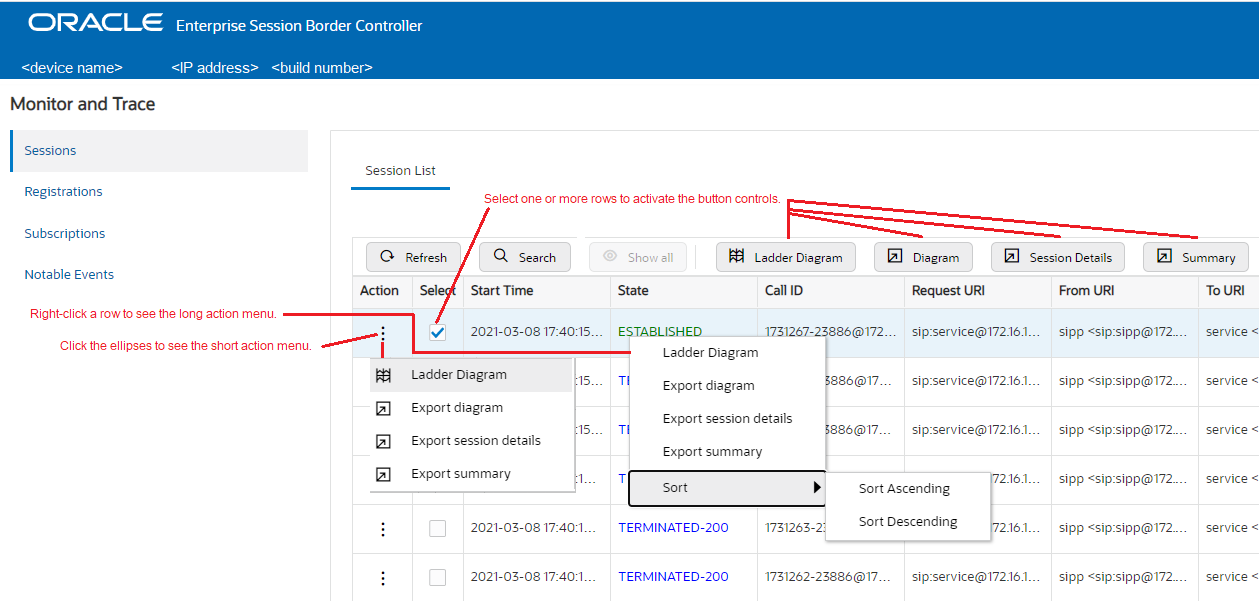
Ladder diagrams contain the following sections.
Session Summary—Displays session data. Use the [+] and [-] controls to toggle between show and hide. The default is hide.
Ladder Diagram—Displays SIP message and call flow information. Hover over a line in the ladder diagram to see more information about the highlighted flow.
QoS Stats—Displays Quality of Service (QoS) information. Use the [+] and [-] controls to toggle between show and hide. The default is hide. You must enable Quality of Service (QoS) on your system to see the QoS Statistics information.
The following screen capture shows an example of a ladder diagram as initially displayed with the Session Summary and QoS Stats sections hidden.

The following screen capture shows an example of an ECB ladder diagram with the Session Summary and QoS sections expanded. This screen capture also shows an example of the pop-up that displays detailed SIP Message Details when you hover over a row in the diagram.
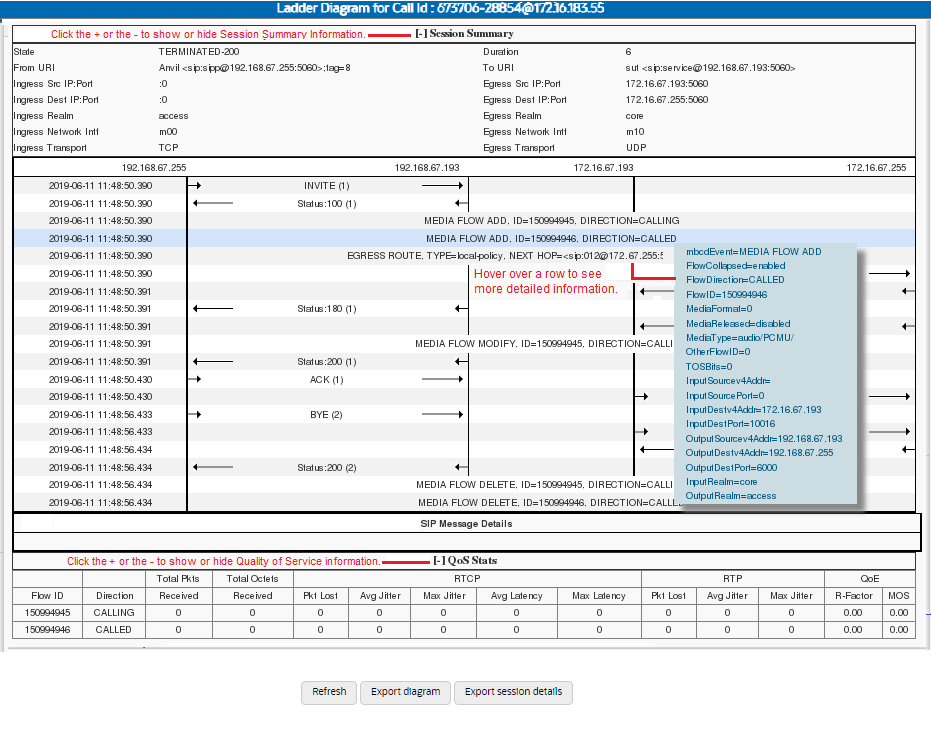
Note:
The ECB captures SIP messages, applies the Header Manipulation Rules (HMR) that you configured on the ECB, and applies the Session Plug-in Language (SPL) to that message. When the ECB sends the message, it applies the SPL, the HMR, and sends the captured SIP message. When viewing the session detail on a Ladder Diagram, the HMR and SPL information may be present.Ladder Diagram Controls
Ladder diagrams display the following controls at the bottom of the page.
Refresh—Use to refresh the data in the ladder diagram.
Export diagram—Use to export the ladder diagram to an HTML file.
Export session details—Use to export the session details to a text file.
Close and Remove Ladder Diagram Tabs
To remove an individual tab you can either click the X on the tab or right-click and click Remove on the pop-up menu.
To remove all tabs, right-click a tab and click Close All on the pop-up menu.
Display a Ladder Diagram
You can display a ladder diagram of call and media flow data from the Sessions, Registrations, Subscriptions, and Notable events lists in Monitor and Trace. Each list page displays a table, where each row represents one session. You can view a ladder diagram for each session with the following procedure.
Session Summary
To see a Session Summary, open a ladder diagram from a record in a Summary report and click the [+] control that precedes "Session Summary" at the top of the page. Monitor and Trace displays the session data and statistics.

| State | Status of the call or media session. Valid values
are:
INITIAL—Session for which an INVITE or SUBSCRIBE was forwarded. EARLY—Session received the first provisional response (1xx other than 100). ESTABLISHED—Session for which a success (2xx) response was received. TERMINATED—Session that has ended by receiving or sending a BYE for an “Established” session or forwarding an error response for an “Initial” or Early session. The session remains in the terminated state until all the resources for the session are freed up. FAILED—Session that has failed due to a 4xx or 5xx error code. |
| Duration | Amount of time, in seconds, that the call or media session was active. |
| From URI | URI formatted string that identifies the call source information. |
| To URI | URI formatted string that identifies the call destination information. |
| Ingress Src IP:Port | Source IP address and port number of the incoming call or media session. |
| Egress Src IP: Port | Source IP address and port number of the outgoing call or media session. |
| Ingress Dest IP:Port | Destination IP address and port number of the incoming call or media session. |
| Egress Dest IP: Port | Destination IP address and port number of the outgoing call or media session. |
| Ingress Realm | Incoming realm name. |
| Egress Realm | Outgoing realm name. |
| Ingress Network Intf | Name of the incoming network interface on the Oracle Enterprise Communications Broker (ECB). |
| Egress Network Intf | Name of the outgoing network interface on the ECB. |
| Ingress Transport | Protocol type used on the incoming call or media session. Valid values are User Datagram Protocol (UDP) or Transport Control Protocol (TCP). |
| Egress Transport | Protocol type used on the outgoing call or media session. Valid values are User Datagram Protocol (UDP) or Transport Control Protocol (TCP). |
Display a Session Summary
You can view data and statistics about a call or media session by displaying the Session Summary from a ladder diagram.
- Under the Monitor and Trace
tab, select one of the following summaries:
- Sessions
- Registrations
- Subscriptions
- Notable Events
- On the Summary page, select a row in the table and right-click.
- On the pop-up menu, click Ladder Diagram.
- (Optional)—On the ladder diagram, click the [+] to expand the Session Summary section.
QoS Statistics
The Quality of Service (QoS) Stats section of the Session Summary displays information about the quality of the service for a selected call session or media event. To see the QoS statistics, open a ladder diagram from a record in a Summary report and click the [+] control that precedes "QoS Statistics" at the bottom of the page.
Expand QoS Stats section with the [+} control.

The following table describes each column in the QoS Stats report.
| Flow ID | ID number assigned to the call session or media event flow of data. |
| Direction | The direction of the call or media event flow.
CALLING—egress direction CALLED—ingress direction |
| Total Pkts Received | Total number of data packets received on the interface during the active call session or media event. |
| Total Octets Received | Total number of octets received on the interface during the active call session or media event. |
| RTCP | Real-time Transport Control Protocol—used to send control packets to participants in a call. |
| Pkts Lost | Number of RTCP data packets lost on the interface during the active call session or media event. |
| Avg Jitter | Average measure of the variability, called jitter, over time of the RTCP packet latency across a network. A network with constant latency has no jitter. Jitter is referred to as Packet Delay Variation (PDV). It is the difference in the one-way end-to-end delay values for packets of a flow. Jitter is measured in terms of a time deviation from the nominal packet inter-arrival times for successive packets. |
| Max Jitter | Maximum measure of the variability, called jitter, over time of the RTCP packet latency across a network. A network with constant latency has no variation jitter. |
| Avg Latency | Average observed one-way signaling latency during the active window period. This is the average amount of time the signaling travels in one direction. |
| Max Latency | Maximum observed one-way signaling latency during the sliding window period. This is the maximum amount of time the signaling travels in one direction. |
| RTP | Real-Time Transport Protocol—a standard packet format for delivering audio and video over the internet. |
| Pkts Lost | Number of RTP data packets lost on the interface during the active call session or media event. |
| Avg Jitter | Average measure of the variability, called jitter, over time of the RTP packet latency across a network. A network with constant latency has no jitter. Jitter is referred to as Packet Delay Variation (PDV). It is the difference in the one-way end-to-end delay values for packets of a flow. Jitter is measured in terms of a time deviation from the nominal packet inter-arrival times for successive packets. |
| Max Jitter | Maximum measure of the variability, called jitter, over the time of the RTP packet latency across a network. A network with constant latency has no jitter. |
| QoE | Quality of Experience—measurement used to determine how well the network is satisfying the end user's requirements. |
| R-Factor | Rating Factor—An average Quality of Service (QoS) factor observed during the active window period. QoS shapes traffic to provide different priority and level of performance to different data flows. R-Factors are metrics in VoIP that use a formula to take into account both user perceptions and the cumulative effect of equipment impairments to arrive at a numeric expression of voice quality. This statistic defines the call or transmission quality, which is expressed as an R factor. |
| MOS | Mean Opinion Score (MOS) score—MOS is a measure of voice quality. MOS provides a numerical indication of the perceived quality of the media received after being transmitted and eventually compressed using Codecs. |
Display QoS Statistics
- Under the Monitor and Trace
tab, select one of the following summaries:
- Sessions
- Registrations
- Subscriptions
- Notable Events
- On the Summary page, select a row in the table and right-click.
- On the pop-up menu, click Ladder Diagram.
- On the ladder diagram, click the [+] to expand the QoS Stats section.
SIP Monitor and Trace Filter Configuration
The SIP Monitor and Trace function allows you to monitor SIP sessions for notable events and display the results in the Oracle Enterprise Communications Broker (ECB) SIP Notable Events summary. Such information may help you perform troubleshooting. For more targeted monitoring, you can configure filters on particular users and addresses on the ECB, and on a specific agent.
- The SIP Interface configuration page displays the
Monitoring
Filters object in the navigation pane, which you use to
configure individual filters.
Figure 16-1 filter config dialog

- The Monitoring object
on the SIP interface configuration page displays the Monitoring
Filters element in the dialog. Use it to apply filters to the
ECB.
Figure 16-2 Modify Filter Config

- The Add Agents configuration page displays the
Monitoring
Filters configuration element to the Advanced section. Use it to
apply filters to an agent.
Figure 16-3 Monitoring Filters
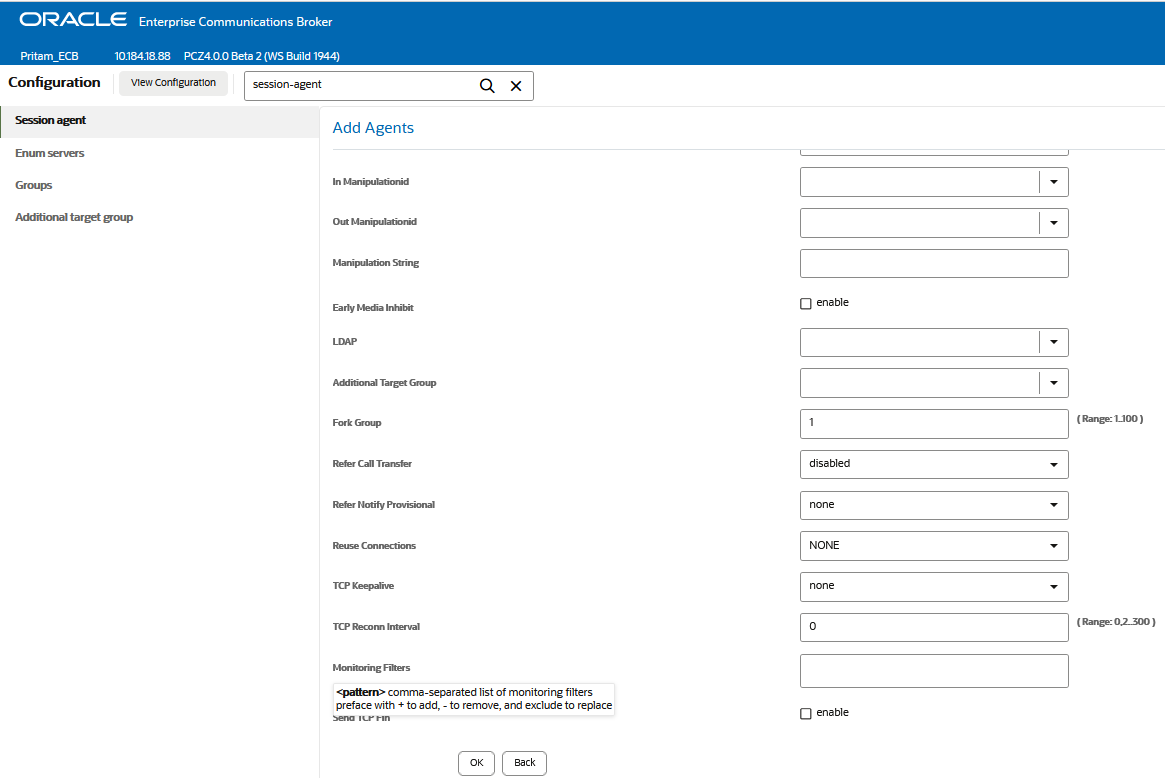
-
Note:
After the P-CZ2.0.0m4 release, the system does not support the former "Enable SIP Monitor and Trace" setting. You must re-configure SNMP event traps through the dialogs described in this topic.
- Create one or more filters in the Monitoring Filters object. You may use an asterisk character as a filter, if you want to monitor all session data.
- Add one or more filters to the Monitoring object.
- (Optional) Add one or more monitoring filters to an agent that you want to monitor.
Search for a Record
The Search button at the top of the report page allows you to find a specific record within a Monitor and Trace report. It also allows you to specify criteria on which to perform the search.
After defining a search criteria in the Search Filter dialog box, clicking Search automatically populates the report page with the records that match the specified criteria specified. The search performs the filtering process of criteria dependent on the report page from which you are running the search.
Note:
A SIP Monitor and Trace global search can find items in the SIP headers, as well.The system saves the search criteria until you click Reset in the dialog box, or until you log out of the HTTP session.
Search for a Report Record
Use the Search button located above the report table to help you find a specific record in an Oracle Enterprise Communications Broker (ECB) Monitor and Trace report. When you click Search, the Web GUI displays a dialog where you specify criteria for the search.
- If you specify the “*” character in a search string, the search is performed on that exact string. For example, if you search for “123*45”, the search shows results for all strings containing “123*45”.
- You can use quotes (“ “) to specify a search. For example, you can enter Smith and the search finds all of the records that match Smith, such as: John Smith field<sip:sipp@192.168.1.70:5070>;tag=12260SIPpTag001.
- When you enter a space before or after a quotation mark, (for example, “Smith “), the search returns no data.
Specify Additional Identifiers
To specify additional identifiers:
- In the Session Id field, enter the ID of the call session you want to search. Valid values are alpha-numeric characters. For example, 22-3412@172.16.34.1.
- In the In Call ID field, enter the ID of the incoming call (phone number and source IP address). Valid values are alpha-numeric characters. For example, 25-3412@172.16.34.10.
- In the Out Call ID field, enter the ID of the outgoing call (phone number and IP address). Valid values are alpha-numeric characters. For example, 14-3412@172.14.54.6.
- In the State (with result code) field, enter the status of the call session with the result code for which you want to search. Valid values are (case-sensitive):
-
INITIAL-<result code>
-
EARLY-<result code>
-
ESTABLISHED-<result code>
-
TERMINATED-<result code>
-
FAILED-<result code>
Result codes can range from 1xx to 5xx. For example, terminated-200, or failed-400.
-
- In the Notable Event field, select the notable event for which you want to search. Valid values are:
-
any-event - search displays any notable event that was stored in memory.
-
short-session - search displays only records that indicate a short-session duration has occurred.
-
local-rejection - search displays only records that indicate a local-rejection has occurred.
-
- To search on additional parameters, click on the Additional Search Options down arrow to expand the dialog box.
Specify Additional Search Options
To specify additional search options:
- In the “In Realm” field, enter the name of the realm for which the incoming call belongs. Valid values are alpha-numeric characters. For example, access.
- In the “Out Realm” field, enter the name of the realm for which the outgoing call belongs. Valid values are alpha-numeric characters. For example, backbone.
- In the “In SA” field, enter the name of the session agent (SA) on the incoming call session. Valid values are alpha-numeric characters. For example, SA1.
- In the “Out SA” field, enter the name of the session agent (SA) on the outgoing call session. Valid values are alpha-numeric characters. For example, SA2.
- In the “In Source Addr” field, enter the source IP address of the SA that accepted the incoming call session. IP Address must be entered in dotted decimal format (0.0.0.0). For example, 172.45.6.7.
- In the “Out Dest Addr” field, enter the destination IP address of the SA that accepted the outgoing call session. IP Address must be entered in dotted decimal format (0.0.0.0). For example, 172.64.56.7.
- In the In Network Interface field, enter the incoming core network interface that connects the Net-Net ECB to your network. IP Address must be entered in dotted decimal format (0.0.0.0). For example, 192.45.6.7.
- In the Out Network Interface field, enter the outgoing network interface that connects your Net-Net ECB to the outside network. IP Address must be entered in dotted decimal format (0.0.0.0). For example, 192.45.6.8.
- Click <Search> to perform the search with the values you specified. A list of the records that the search process filtered, display in the window. The GUI saves the search specifications until you click <Reset> in the search dialog box, OR until you log out of the GUI.
Export Monitor and Trace Information to a Text File
Monitor and Trace allows you to export Monitor and Trace information to a text file from the Sessions, Registrations, Subscriptions, and Notable Events Reports.
- Select a row and click one of the export buttons displayed above the report list.
- Select a row, right click, and click an export operation on the menu.
- Click the ellipses on a row and click an export operation on the menu.
The following list describes the export commands.
| Diagram | Exports all of the information in the Ladder Diagram (Session Summary, SIP Message Details, and QoS statistics), to an HTML file format. |
| Session Details | Exports detailed information about the SIP messages and media events in the Ladder Diagram associated with the selected session, to a file in text format. |
| Summary | Exports all logged session summary records to a file in text format. |